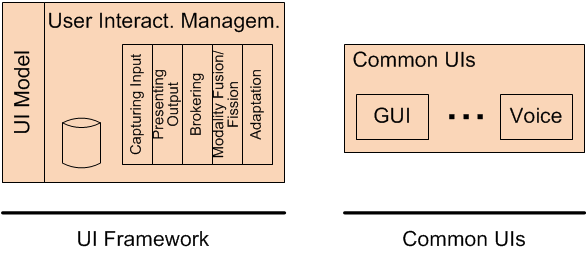Home
| Links of Interest | |
|---|---|
| Pax Composite Bundle | - |
| Karaf Feature | - |
| Javadoc | https://universaal.github.io/ui/ui.pom/apidocs/index.html |
| Maven Site | https://universaal.github.io/ui/ui.pom/index.html |
| Repository Status | https://github.com/universAAL/platform/wiki/Repository-Status |
| Maven Release Repository | http://depot.universaal.org/maven-repo/releases/org/universAAL/ui/ |
| Maven Snapshot Repository | http://depot.universaal.org/maven-repo/snapshots/org/universAAL/ui/ |
This group identifies solutions for explicit interaction between a human user and uSpaces. This goes beyond the traditional human-computer interaction (HCI) where the interaction is usually assumed to be bound to one single computer and its peripherals. We address the shift of paradigm from HCI to HEI – human-environment interaction [1].
HEI, however, includes both the implicit and the explicit interaction. In universAAL, the Service Infrastructure and Context Management expert groups deal with the implicit interaction in uSpaces, and the User Interaction Management (UIM) expert group is responsible for the explicit interaction which stayed in the shadow of implicit interaction for a long time [2]. With the proliferation of (multi-)touch sensing, big displays as well as small displays embedded in all possible devices, and new interaction forms supported by special devices (e.g. Nintendo WiiMote and Microsoft Kinect) on one side, and progresses in speech recognition, natural language processing, and gesture recognition on the other side, explicit user interaction in smart environments is becoming more and more important.
As a matter of fact, the universAAL expert groups have been formed during the consolidation and generalization of the system architectures of the so-called input projects towards the universAAL concrete architecture. Therefore, there is often a direct relationship between the expert groups and certain architectural artefacts of universAAL in a way that they influence each other bilaterally, especially when it comes to definitions. Next figure shows universAAL concrete architecture with highlighted UI building blocks:

In case of the UIM expert group, the following abstract building blocks from the System Decomposition Model in the universAAL deliverable D1.3 Part IV fall into the scope of the UIM expert group:

- The UI Framework building block as one of the mandatory space-level managers is supposed to address the challenges related to explicit interaction between uSpaces and its human users. It must provide for independence of applications from the concrete I/O infrastructure (set of concrete I/O channels) available in uSpaces as the latter might differ in its occurrences considerably. It must define a framework for capturing user input and presenting system output to human users thereby brokering between applications and the concrete setup in the uSpace at hand. Two major challenges in this conjunction are the support for multimodality and guaranteeing the adaptation of presentation to the user situation and needs. The existence of a unified UI model might facilitate the provision of such a UI framework.
The UI Framework consists of: - The Common UIs building block serves as a placeholder for the pickable space-level managers that belong to the "presentation" layer, namely the I/O channel managers abbreviated here as UI handlers. Assuming that the separation between presentation and application tiers is achieved by the UI Manager above, UI handlers can be added, removed or replaced dynamically and freely; hence, they belong to the configuration-specific set of managers. This kind of managers would be responsible for capturing human input (with or without modality fusion) and presenting system output to humans (with or without modality fission) in an application-independent way.
The Common UIs consists of:
- ^ Encarnação J (2007) HEI!: the human environment interaction. In LNCS 4557: Human Interface and the Management of Information. Springer, Berlin / Heidelberg, 623-631.
- ^ To satisfy the core requirement that intelligent environments should automatically react to the contextual changes as far as reasonable, researchers were mostly focused on capturing changes in the context and providing mechanisms for automatic reaction upon such changes.